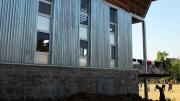The magic bus campus, designed by professor of urban design and planning Rahul Mehrotra, aims to ease cultural divides starting with India’s youngest citizens. The name of the nongovernmental organization (NGO) refers to the bus that brings children from Mumbai’s slums to a haven of green 60 kilometers outside the city. Children come for the day or for a week to engage in the usual summer-camp programming: games, arts and crafts, canoeing, hiking, soccer, a ropes course. But for these children, the camp is a whole new world.
Here in the countryside, the sky is bright blue instead of Mumbai’s dull gray. The ambient sounds are chirping birds, buzzing insects, and wind in the trees—not honking horns. Children tend to be “pretty stunned” when they arrive, says Rob Thomas, director of the camp, which opened in 2005. The grounds must seem impossibly spacious to children who come from a place where every available square foot is used with maximum efficiency, and pedestrian passageways are often so narrow that people walking in opposite directions must turn sideways to pass each other. Many of the children already work to help support their families; away at camp for a week, they are allowed to be children.
When designing the buildings for this important space, Mehrotra didn’t want to fetishize country living by using stereotypical materials such as thatch roofs and mud walls. Instead, he chose materials commonly used in the slums where the campers live; in fact, his team visited a slum to create a “palette” for the project—so when the children arrive in this very foreign place, they find some familiar details. To avoid making the camp a “caricature,” though, he took care to present the transplanted materials in new ways: the angular, modern cabins have metal roofs, so the sound of rain mimics what the children might hear at home. Blue plastic tarps become rain shields, unfurled along the sides of the open-air dining hall during monsoon season.
On a dry, sunny Thursday in January, the group on the camp’s athletic field, rambunctiously raising flags in a team-building exercise, was the senior class from the American School of Bombay. (Paying groups subsidize the experience for poor children, who come for free.) Yet even these children from wealthier families seldom see green space in Mumbai. The camp experience is transformative for them, too, says Thomas: “Just cognitively, you can’t think about things in a big way if you’re always penned in.”
Mehrotra’s habit of using familiar materials in new ways and unexpected locations is also eye-opening for the private-school group in a way he didn’t foresee when designing the site. Eating in the concrete-floored dining hall and sleeping under a metal roof, they get acquainted with materials from the slum; although these campers probably don’t realize it, they are sharing an experience with their poorer peers.











